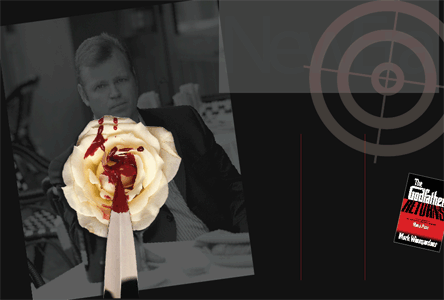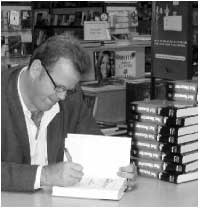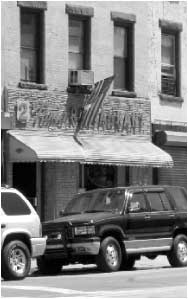 By Ron Rollins '82 By Ron Rollins '82
 The pretty, leafy walks and red bricks of Oxford might seem a long way from Vito Corleone's New York gangster compound and Michael Corleone's bloody Las Vegas casinos, but guess what? They're connected far more closely than you might imagine. The pretty, leafy walks and red bricks of Oxford might seem a long way from Vito Corleone's New York gangster compound and Michael Corleone's bloody Las Vegas casinos, but guess what? They're connected far more closely than you might imagine.
The guy who ties them together ever so neatly is Mark Winegardner, the Ohio native and current Florida resident who was chosen by Random House and the estate of Mario Puzo to write the official, authorized sequel to that touchstone of American culture, The Godfather.
Winegardner, 43, cut his writerly teeth on the campus of Miami University, from which he graduated with an English degree in 1983 - as he'll proudly tell you.
"I'm first-generation college in my family, and so my undergraduate education was probably more pivotal for me than for a lot of people. Like most people that age, I had a dream but no real idea how to achieve it. I knew vaguely that I wanted to be a writer, and that was made possible by Miami."
He arrived from the small, northwestern Ohio city of Bryan with notions of learning journalism, which seemed like a good way to write a lot and someday get paid for it. He offered his services to The Miami Student almost as soon as he arrived on campus and before long was writing a popular humor column that made him a campus personality.
Wino, as his friends call him, worked as a copy editor, editorial page editor, and managing editor, but realized after a while that "journalism wasn't the main thing." Interviewing real people wasn't as much fun, or nearly as satisfying, as giving voice on the page to the make-believe people who were already having conversations inside his head.
Besides, he enjoyed being in classrooms more than newsrooms. English professors Don Daiker and Max Morenberg stand out in his memory as the two teachers who made a lasting impact on him, especially Daiker's "incredible enthusiasm for a well-turned phrase." Winegardner left Miami knowing he wanted to teach at the college level and in a few years ended up at John Carroll University in Cleveland.
It was in Cleveland that he also began establishing himself as a writer of national note - say, the sort of author who might attract the attention of New York publishers and editors looking for the perfect guy to pick up some of the most beloved, memorable stories in American popular culture.
Between 1988 and 2002, he produced seven novels, nonfiction narratives, or story collections, from the 1996 baseball novel The Veracruz Blues to his biography of a legendary baseball scout in 1990's Prophet of the Sandlots. Readers noted his ability to place colorful regional history into a larger context, to spin family stories into bigger drama, and to explore the idea of mythology and how it changes over the life of a culture.
The most critically acclaimed of his books was the novel Crooked River Burning, a 2001 saga set in the city he loved, Cleveland, and which wove the stories of several families with such historical figures as Mayor Carl Stokes and pioneering rock 'n' roll DJ Alan Freed. The book was good enough, and well-reviewed enough, that a year later when administrators of Mario Puzo's estate went looking for a writer, they didn't have a hard time coming up with one who met their exacting specifications.
The family wanted to finally update The Godfather. Though the 1969 novel enjoyed two big-screen sequels based on the 1972 film version, and though Puzo had a hand in writing them, he had never published a sequel to his book. After an international search, the Puzos and Random House announced in 2002, to considerable media fanfare, that they had found their man. Then Winegardner had to get to work.

Seen here autographing The Godfather Returns at the Florida State University Bookstore, Mark Winegardner '83 has signed on with G.P. Putnam's Sons to write The Godfather's Revenge, billed as the capstone to the Corleone family saga. |
He took a sabbatical from his job as director of the creative writing program at Florida State University in Tallahassee, where he had been for several years after moving from Cleveland. He also took a break from a normal social and family life and a regular sleep schedule. Random House wanted The Godfather Returns as its big book of fall 2004 - a pretty quick turnaround.
Winegardner plunged into research, learning all he could about the Mafia, and realized quickly that American popular culture's immersion in mob lore today, thanks largely to the success of The Godfather, was both a blessing and a curse. It meant an audience was out there waiting, but it was a sophisticated audience who would demand that he got the story right.
"If you've seen two episodes of The Sopranos, you know more about the mob than J. Edgar Hoover knew in the 1960s," Winegardner says, noting that before Puzo's novel not a great deal was popularly known about the internal workings of organized crime.
"But that's what made me want to write it - this was the glory era of the American mob, the 1950s and '60s - it's the thing that superceded the Western as America's core mythology. I was thrilled to be entrusted with this story."
He also realized while reviewing the story again, and paying attention to how the movies fit around the novel, that there were numerous gaps in plot and family history between the end of the first and second films. Winegardner decided to focus on the years 1955 to 1962 and fill in the characters of not just Michael Corleone, who goes through a struggle to legitimize the family business, but also of his aimless brother Fredo, his sharp but tragic wife, Kay, the daughters of the murdered Sonny, and the rage-filled Tom Hagan, the consigliere who gets shunted off to the side as Michael gains power.
"The book has no three-dimensional female characters, and I wanted to correct that," Winegardner says.
"I also wanted to fill in Michael's back story during World War II - he was a war hero in the Pacific, so he wasn't weak. I always wanted to know what Michael did during the war.
"And there's the whole thing of Rat Pack Las Vegas," he says. "Didn't you always want to see that? Now you can."
The book came in on time, to smashing sales - it perched for several weeks on The New York Times best-seller list - and great reviews.
"Winegardner has matched risk with risk and told an ambitious story, panoramic and cinematic," wrote Martin Schmutterer in the Minneapolis Star Tribune. "Winegardner breathes new life into The Godfather, even as it subverts its mythology. Instead of being handcuffed by the limitations inherent in such a project, he has made the story his own, much the same way Coppola did."
"The Godfather Returns is not only a real book by a real writer. It's also a real pleasure, a fine, swirling epic - bitter, touching, funny, and true," Sarah Vowell said in The New York Times Book Review.
All this led to a dizzying swirl of lectures, interviews, book tours, sign-ings, radio appearances, and photo sessions that had Winegardner's blond-haired mug plastered in everything from Entertainment Weekly to USA Today.
As much as he enjoyed the response, he was sometimes bewildered by it all. He's faced what seem like "millions" of interviewers who joke about Random House making him an offer he couldn't refuse ("Hey, I haven't heard that one!" he quips) and gets a chuckle from the fact that outside the United States, The Godfather Returns is most popular in Norway, of all places.

Two Toms, the Italian restaurant and meeting place for the wise guys who carry out The Godfather Returns’ novel-opening hit on Salvatore Tessio, one of Michael Corleone’s betrayers. |
"I don't understand it," he says, "but they go nuts over mob stuff over there."
His most recent swing through his home state happened last spring for a series of lectures sponsored by the Ohio Humanities Council that took him to Akron, Canton, Cincinnati, Cleveland, Columbus, Dayton, and Toledo.
During his talk at the University of Dayton, Winegardner discussed the intense deadline pressures of producing The Godfather Returns, acknowledging the support he got from his wife, who's an attorney, and their three kids - but admitting that the project became "an obsessive, all-encompassing thing; there were a lot of very close personal friends I just didn't see for two years."
He also stressed that the effort was very much worth it. The reason he enjoyed taking on the Corleone saga was that "I want to make sure I'm not writing a book about a small subject." Puzo's tale stands as an iconic cultural force, and yet unspools in very personal human terms - it's important, but also interesting.
"And your book has to be inter-esting," Winegardner observed. "Most writers don't understand that."
And so, what is the next big, interesting thing? Winegardner, who's back at Florida State, is indulging a newfound passion for NASCAR, a topic he wrote about for Playboy magazine. And he's revisited the Corleones quite recently in the heavily promoted new Godfather video game produced by EA Games.
"I co-wrote the script, which was great because I got to write dialogue that Marlon Brando spoke," Winegardner said. "It was really exciting - there's a greater level of sophistication in the storytelling in a video game, lots of things you can do that you can't do in a novel or a movie."
He's also been planning to start a new novel he tentatively calls Smut, about a Cleveland businessman who became America's first pornography kingpin. Historically based, it contains all the elements Winegardner enjoys - true-life characters, a rich and complex topic, and a way to explore modern myth making.
"This is the guy who built the porn industry into an actual industry, and nobody today remembers him. It's a great story."
But before Winegardner's desk is completely overtaken by Smut, he'll be writing one more Godfather novel.
"I always thought of this as one big two-volume novel," he said. "I wanted The Godfather Returns to finish with a great cliffhanger ending [which includes, among other things, members of the mob who want to kill the president]. The Godfather's Revenge will pick the story up from there and show us the Corleone family - and the American mob - during the 1960s and early '70s.
"All we know about that era in The Godfather saga is that Tom Hagen dies. That's it, but we don't know how. In real-life Mafia history, the '60s were a rich time, in every sense of that, but in The Godfather saga, these are the truly missing years."
Ron Rollins '82 worked with Winegardner at The Miami Student. A freelance writer from Kettering, Ohio, he's an editor at the Dayton Daily News. His wife, Amy, is Miami Class of 1983.
 Back to the Miamian Magazine Fall 2007 Web page Back to the Miamian Magazine Fall 2007 Web page
|
 By Ron Rollins '82
By Ron Rollins '82 The pretty, leafy walks and red bricks of Oxford might seem a long way from Vito Corleone's New York gangster compound and Michael Corleone's bloody Las Vegas casinos, but guess what? They're connected far more closely than you might imagine.
The pretty, leafy walks and red bricks of Oxford might seem a long way from Vito Corleone's New York gangster compound and Michael Corleone's bloody Las Vegas casinos, but guess what? They're connected far more closely than you might imagine.
